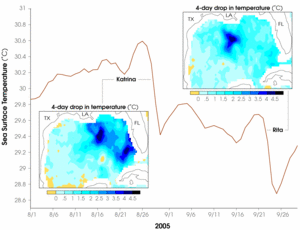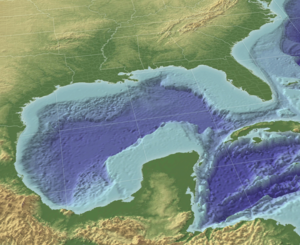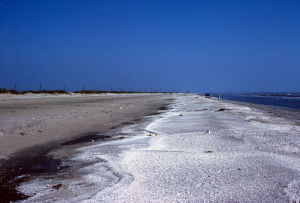Gulf of Mexico
2008/9 Schools Wikipedia Selection. Related subjects: Geography
The Gulf of Mexico (Spanish:Golfo de México) is the ninth largest body of water in the world. Considered a smaller part of the Atlantic Ocean, it is an ocean basin largely surrounded by the North American continent and the island of Cuba. It is bounded on the northeast, north and northwest by the Gulf Coast of the United States, on the southwest and south by Mexico, and on the southeast by Cuba. The shape of its basin is roughly oval and approximately 810 nautical miles (1,500 km) wide and filled with sedimentary rocks and debris. It is part of the Atlantic Ocean through the Florida Straits between the U.S. and Cuba, and with the Caribbean Sea (with which it forms the American Mediterranean Sea) via the Yucatan Channel between Mexico and Cuba. Tidal ranges are extremely small due to the narrow connection with the ocean. The gulf basin is approximately 615,000 mi² (1.6 million km²). Almost half of the basin is shallow intertidal waters. At its deepest it is 14,383 ft (4,384 m) at the Sigsbee Deep, an irregular trough more than 300 nautical miles (550 km) long. It was probably formed approximately 300 million years ago as a result of the seafloor sinking. There is evidence that the Chicxulub Crater was formed when a large meteorite hit the earth 65 million years ago which may have led to the Cretaceous–Tertiary extinction event.
History
Formation
Little is known about the geologic history of the Gulf of Mexico Basin before Late Triassic time. Some authors have postulated the presence of a basin in the area during most of Paleozoic time, but most evidence seems to indicate that Paleozoic rocks do not underlie most of the Gulf of Mexico basin and that the area was, at the end of Paleozoic time, part of the large supercontinent of Pangea, the result of the collision of several continental plates.
The present Gulf of Mexico basin is believed to have had its origin in Late Triassic time as the result of rifting within the North American Plate at the time it began to crack and drift away from the African and South American plates. Rifting probably continued through Early and Middle Jurassic time with the formation of "stretched" or "transitional" continental crust throughout the central part of the basin. Intermittent advance of the sea into the continental area from the west during late Middle Jurassic time resulted in the formation of the extensive salt deposits such as the Brine pool. It appears that the main drifting episode, during which the Yucatan block moved southward and separated from the North American Plate and true oceanic crust formed in the central part of the basin, took place during the early Late Jurassic, after the formation of the salt deposits.
Since Late Jurassic time, the basin has been a stable geologic province characterized by the persistent subsidence of its central part, probably due at first to thermal cooling and later to sediment loading as the basin filled with thick prograding clastic wedges along its northwestern and northern margins, particularly during the Cenozoic.
To the east, the stable Florida platform was not covered by the sea until the latest Jurassic or the beginning of Cretaceous time. The Yucatan platform was emergent until the mid-Cretaceous. After both platforms were submerged, the formation of carbonates and evaporites has characterized the geologic history of these two stable areas. Most of the basin was rimmed during the Early Cretaceous by carbonate platforms, and its western flank was involved during the latest Cretaceous and early Tertiary in a compressive deformation episode, the Laramide Orogeny, which created the Sierra Madre Oriental of eastern Mexico.
Today, there are 7 main areas of the gulf:
- Gulf of Mexico Basin, which contains the Sigsbee Deep and can be further divided into the continental rise, the Sigsbee Abyssal Plain, and the Mississippi Cone.
- Northeast Gulf of Mexico, which extends from just east of the Mississippi Delta near Biloxi to the eastern side of Apalachee Bay.
- South Florida Continental Shelf and Slope, which extends along the coast from Apalachee Bay to the Straits of Florida and includes the Florida Keys and Dry Tortugas.
- Campeche Bank, which extends from the Yucatan Straits in the east to the Tabasco- Campeche Basin in the west and includes Arrecife Alacran.
- Bay of Campeche, which is an isthmian embayment extending from the western edge of Campeche Bank to the offshore regions just east of the port of Veracruz.
- Western Gulf of Mexico, which is located between Veracruz to the south and the Rio Grande to the north.
- Northwest Gulf of Mexico, which extends from Alabama to the U.S.-Mexico border.
European exploration
Although Christopher Columbus was credited with the discovery of the Americas, the ships in his four voyages never reached the Gulf of Mexico. Instead, Columbus sailed into the Caribbean around Cuba and Hispaniola.
The first European exploration of the Gulf of Mexico was Amerigo Vespucci in 1497. He followed the coastal land mass of central America before returning to the Atlantic Ocean via the Straits of Florida between Florida and Cuba. In his letters, Vespucci described this trip, and once Juan de la Cosa returned to Spain, a famous world map, depicting Cuba as an island, was produced.
In 1506, Hernán Cortés took part in the conquest of Hispaniola and Cuba, receiving a large estate of land and Indian slaves for his effort. In 1510, he accompanied Diego Velázquez de Cuéllar, an aide of the governor of Hispaniola, in his expedition to conquer Cuba. In 1518 Velázquez put him in command of an expedition to explore and secure the interior of Mexico for colonization.
In 1517, Francisco Hernández de Córdoba discovered the Yucatán Peninsula. This was the first European encounter with an advanced civilization in the Americas, with solidly-built buildings and a complex social organization which they recognized as being comparable to those of the Old World; they also had reason to expect that this new land would have gold. All of this encouraged two further expeditions, the first in 1518 under the command of Juan de Grijalva, and the second in 1519 under the command of Hernán Cortés, which led to the Spanish exploration, military invasion, and ultimately settlement and colonization known as the Conquest of Mexico. Hernández did not live to see the continuation of his work: he died in 1517, the year of his expedition, as the result of the injuries and the extreme thirst suffered during the voyage, and disappointed in the knowledge that Diego Velázquez had given precedence to Grijalva as the captain of the next expedition to Yucatán.
In 1523, Ángel de Villafañe sailed to Mexico City and shipwrecked along the coast of Padre Island, Texas in 1554. When word of the disaster reached Mexico City, the viceroy requested a rescue fleet and immediately sent Villafañe marching overland to find the treasure-laden vessels. Villafañe traveled to Pánuco and hired a ship to transport him to the site, which had already been visited from that community. He arrived in time to greet García de Escalante Alvarado (a nephew of Pedro de Alvarado), commander of the salvage operation, when Alvarado arrived by sea on July 22, 1554. The team labored until September 12 to salvage the Padre Island treasure. This loss, in combination with other ship disasters around the Gulf of Mexico, gave rise to a plan for establishing a settlement on the northern Gulf Coast to protect shipping and more quickly rescue castaways. As a result, the expedition of Tristán de Luna y Arellano was sent and landed at Pensacola Bay on August 15, 1559.
On December 11, 1526, Charles V granted Pánfilo de Narváez a license to claim what is now the Gulf Coast of the United States, known as the Narváez expedition. The contract gave him one year to gather an army, leave Spain, be large enough to found at least two towns of one hundred people each, and garrison two more fortresses anywhere along the coast. On April 7, 1528, they spotted land north of what is now Tampa Bay. They turned south and traveled for two days looking for a great harbour the master pilot Miruelo knew of. Sometime during these two days, one of the five remaining ships was lost on the rugged coast, but nothing else is known of it.
In 1697, Pierre Le Moyne d'Iberville sailed for France and was chosen by the Minister of Marine to lead an expedition to rediscover the mouth of the Mississippi River and to colonize Louisiana which the English coveted. Iberville's fleet sailed from Brest on 24 October 1698. On January 25, 1699, Iberville reached Santa Rosa Island in front of Pensacola founded by the Spanish; he sailed from there to Mobile Bay and explored Massacre Island, later renamed Dauphin Island. He cast anchor between Cat Island and Ship Island; and on February 13, 1699, he went to the mainland, Biloxi, with his brother Jean-Baptiste Le Moyne de Bienville. On May 1, 1699, he completed a fort on the north-east side of the Bay of Biloxi, a little to the rear of what is now Ocean Springs, Mississippi. This fort was known as Fort Maurepas or Old Biloxi. A few days later, on May 4, Pierre Le Moyne sailed for France leaving his teenage brother, Jean-Baptiste Le Moyne, as second in command to the French commandant.
Principal features
The Gulf of Mexico's eastern, north, and northwestern shores lie along the US states of Florida, Alabama, Mississippi, Louisiana, and Texas. This coastline spans 1,680 miles (2,700 km), receiving water from thirty-three major rivers that drain 31 states. The Gulf's southwestern and southern shores lie along the Mexican states of Tamaulipas, Veracruz, Tabasco, Campeche, Yucatán, and the northernmost tip of Quintana Roo. On the southeast it is bordered by Cuba. It supports major American, Mexican and Cuban fishing industries. The outer margins of the wide continental shelves of Yucatán and Florida receive cooler, nutrient-enriched waters from the deep by a process known as upwelling, which stimulates plankton growth in the euphotic zone. This attracts fish, shrimp, and squid. River drainage and atmospheric fallout from industrial coastal cities also provide nutrients to the coastal zone.
The Gulf Stream, a warm Atlantic Ocean current and one of the strongest ocean currents known, originates in the gulf, as a continuation of the Caribbean Current-Yucatán Current- Loop Current system. Other circulation features include the anticyclonic gyres which are shed by the Loop Current and travel westward where they eventually dissipate, and a permanent cyclonic gyre in the Bay of Campeche. The Bay of Campeche in Mexico constitutes a major arm of the Gulf of Mexico. Additionally, the gulf's shoreline is fringed by numerous bays and smaller inlets. A number of rivers empty into the gulf, most notably the Mississippi River in the northern gulf, and the Grijalva and Usumacinta Rivers in the southern gulf. The land that forms the gulf's coast, including many long, narrow barrier islands, is almost uniformly low-lying and is characterized by marshes and swamps as well as stretches of sandy beach.
The Gulf of Mexico is an excellent example of a passive margin. The continental shelf is quite wide at most points along the coast, most notably at the Florida and Yucatán Peninsulas. The shelf is exploited for its oil by means of offshore drilling rigs, most of which are situated in the western gulf and in the Bay of Campeche. Another important commercial activity is fishing; major catches include red snapper, amberjack, tilefish, swordfish, and various grouper, as well as shrimp and crabs. Oysters are also harvested on a large scale from many of the bays and sounds. Other important industries along the coast include shipping, petrochemical processing and storage, military use, paper manufacture, and tourism.

The gulf's warm water temperature can feed powerful Atlantic hurricanes causing extensive human death and other destruction as happened with Hurricane Katrina in 2005. In the Atlantic, a hurricane will draw up cool water from the depths and making it less likely that further hurricanes will follow in its wake (warm water being one of the preconditions necessary for their formation). However, the Gulf is shallower and its entire water column is warm. When a hurricane passes over, although the water temperature may drop it soon rebounds and becomes capable of supporting another tropical storm.
The Gulf is considered aseismic: however, mild tremors have been recorded throughout history (usually 5.0 or less on the Richter scale). A 6.0 tremor was recorded on September 10, 2006, 250 miles (400 km) off the coast of Florida which caused no damage, but could be felt throughout the Southeastern United States. No damage or injuries were reported. Earthquakes such as this may be caused by interactions between sediment loading on the sea floor and adjustment by the crust.
Pollution
There are frequent " red tide" algae blooms that kill fish and marine mammals and cause respiratory problems in humans and some domestic animals when the blooms reach close to shore. This has especially been plaguing the southwest Florida coast, from the Florida Keys to north of Pasco County, Florida.
In July 2008, researchers reported that the dead zone that runs east-west, from near Galveston, Texas to near Venice, Louisiana, was about 8,000 square miles, nearly the record. Between 1985 and 2008, the area roughly doubled in size.
2006 earthquake
On September 10, 2006, the U.S. Geological Survey National Earthquake Information Centre reported that a strong earthquake, ranking 6.0 on the Richter scale, occurred about 250 miles west-southwest of Anna Maria, Florida around 10:56 AM EDT.
The quake was reportedly felt from Louisiana to Florida. There were no reports of major damages or casualties. Items were knocked from shelves and seiches were observed in swimming pools in parts of Florida . The earthquake was described by the USGS as a midplate earthquake, the largest and most widely felt recorded in the past three decades in the region.
According to the September 11, 2006 issue of The Tampa Tribune, earthquake tremors were last felt in Florida in 1952, recorded in Quincy, 20 miles northwest of Tallahassee.



